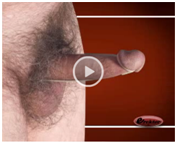Radiographic
Urethrocystography part 1
Introduction
Bead-chain cystography
Standard lateral upright and
straining cystogram
Parameters of urethrocystography
Comparability of perineal
ultrasound and lateral urethrocystography
Introduction
Attempts to determine the
urinary continence mechanism have prompted the study of urethrovesical
relationships by numerous methods, foremost among them the radiographic
techniques of urethrocystography (UCG). Radiologic investigation of the female
bladder and urethra has undergone many changes since its first application at
the beginning of this century (Koelbl et al, 1991).
Fluoroscopy was introduced in the 1920s, and chain cystography has been used
extensively since the publication of Hodgkinson’s method in 1958. Various techniques have been devised to
improve demonstration of the urethra and thus its relationship to the bladder
and pubic symphysis (Tsuchida et al, 1982).
Lateral
urethrocystography and urodynamic assessment with the patients' medical
history, the assessment of their complaints, clinical vaginal examination, and
clinical stress test, they offer valuable information for an efficient
therapeutic concept (Grischke et al, 1991). Imaging for the study of SUI
has until recently been limited to standard radiography and fluoroscopy. More
recently, sonography and magnetic resonance (MR) imaging have been used as
investigative tools in the study of SUI and prolapse. These advanced techniques
are enhancing our understanding of pathophysiology of incontinence, prolapse,
and anatomy in living patients, advancing our existing concepts, and may
eventually fine more general applicability in clinical practice (Mostwin
et al, 1995).
Ultrasound evaluation of
the position and mobility of the urinary BN practically replaced lateral chain
urethrocystography. The functional and physiological conditions of paravaginal
and periurethral structures in women were assessed by physical, urodynamic and
ultrasonography examinations and also by cystourethroscopy (Masata et al,
1998).
Bead-chain cystography
The
placement of a radio-opaque chain of metal beads in the female urethra was the
first important technique used to study urethral position and mobility. It is
clear that the distinguishing topographic pathologic feature is depression of
the urethrovesical junction to the lowest level of the bladder during the peak
of straining effort. It is also clear that the spatial relationship of the
bladder and urethra to the symphysis make no difference in either the incidence
or severity of SUI (Hodgkinson, 1978).
The
loss of posterior urethrovesical angle is synchronous with SUI in women (Hertogs
and Stanton, 1985). Other study, however,
criticized either the predictive value of the techniques or the degree of
blinded inter observer variance (Mouritsen et al, 1993). Measurement of posterior urethrovesical angle (PUVA) by chain
urethrocystography was neither helpful in making the diagnosis nor predictive
of the recurrence of urinary dysfunction (Sumi et al, 2000).
Bead-chain cystography was once the gold standard. Today,
the bead-chain cystourethrogram is hardly ever performed. It has been replaced
by lateral straining cystograms and videourodynamics, from which subsequent
classification systems distinguishing urethral mobility from intrinsic urethral
dysfunction have developed. It certainly served an important purpose,
identifying the relationship between urethral position, closure, and vaginal
mobility (Mostwin et al, 1995).
Standard
lateral upright and straining cystogram
Jeffcoate and Roberts (1952)
introduced lateral urethrocystogram and Hodgkinson (1953) introduced
metallic bead chain urethrocystogram (Stamey, 1992). Bead-chain
cystogram was never widely used in urology. Instead, standard upright static
and straining cystograms were used, probably simplified (Bates et al,
1970) (Figures 1 &2).
Figure 1 A
normal, direct lateral urethrocystogram taking in the straining position from a
continent female. The relationship of UVJ to symphysis pubis in young; normal;
nonporous female was seen (Quoted from Stamey, 1992).
Figure 2 Lateral cystourethrogram with straining in a patient with stress
urinary incontinence. BN position was seen in relation to SCIPP line (Quoted
from Stamey, 1992).
After a plain abdominal film is taken, the contrast
material is instilled into the bladder via a 14-Fr urethral catheter. Contrast
is infused until the patient complains of fullness. The catheter is removed and
in a lateral position, the patient is asked to rest, strain, and void. This
test may objectively show SUI, the BN funnels and opens on stress. In patient
with ISD, the BN is fixed and always open (Raz
et al, 1992). Greatest interest
was not so much on identification of urethral and vaginal movement, per se, but
on identification of urethral incompetence, which now designates ISD. Standard upright lateral cystograms were used
to identify urethral-funneling, vesicalization of urethra, or an incompetent BN as additional signs
indicating urethral dysfunction (Mostwin et al, 1995).
Parameters of
urethrocystography
Urethrocystography
showed in demonstrable incontinence the average posterior urethrovesical angle
was 140 degrees, and in the absence of incontinence 120 degrees. It has been
observed that the relation between the vertical displacement of the internal
urinary meatus in rest and stress was more than 5mm in women with incontinence.
In women without incontinence it was less than 5mm. There was no difference in
the range of the urethral length in women either with or without SUI (Tuskan
et al, 1976). Normally, the BN is above the inferior ramus of
the pubis symphysis and with stress maneuvers, should not descent more than
1cm. When urethrotrigonal angle is greater than 90º it signifies funneling of
BN (Raz et al, 1992).
Bladder neck
dilation was seen in cystourethroscopy and lateral urethrocystography in SU
incontinent women (Behr and Winkler, 1990). Urethrocystography
showed that definite differences between continent and stress-incontinent
patients as regards the pubo-urethral angle, but not as regards the posterior
vesico-urethral angle (Voigt and Starker, 1985).
No
differences were seen in the incidence of radiographic findings in women with
pelvic relaxation with or without SUI. All five cystographic criteria (posterior
and anterior urethral angle, funneling of the proximal urethra on straining,
the position of the urethrovesical junction and flattening of the bladder base)
were similar in the continent and SU incontinent patients (Bergman et al,
1988 II).





